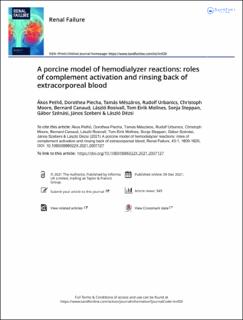| dc.description.abstract | Hemodialysis reactions (HDRs) resemble complement-activation-related pseudoallergy (CARPA) to certain i.v. drugs, for which pigs provide a sensitive model. On this basis, to better understand the mechanism of human HDRs, we subjected pigs to hemodialysis using polysulfone (FX CorDiax 40, Fresenius) or cellulose triacetate (SureFlux-15UX, Nipro) dialyzers, or Dialysis exchange-set without membranes, as control. Experimental endpoints included typical biomarkers of porcine CARPA; pulmonary arterial pressure (PAP), blood cell counts, plasma sC5b-9 and thromboxane-B2 levels. Hemodialysis (60 min) was followed by reinfusion of extracorporeal blood into the circulation, and finally, an intravenous bolus injection of the complement activator zymosan. The data indicated low-extent steady rise of sC5b-9 along with transient leukopenia, secondary leukocytosis and thrombocytopenia in the two dialyzer groups, consistent with moderate complement activation. Surprisingly, small changes in baseline PAP and plasma thromboxane-B2 levels during hemodialysis switched into 30%–70% sharp rises in all three groups resulting in synchronous spikes within minutes after blood reinfusion. These observations suggest limited complement activation by dialyzer membranes, on which a membrane-independent second immune stimulus was superimposed, and caused pathophysiological changes also characteristic of HDRs. Thus, the porcine CARPA model raises the hypothesis that a second “hit” on anaphylatoxin-sensitized immune cells may be a key contributor to HDRs. | en_US |

